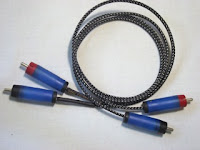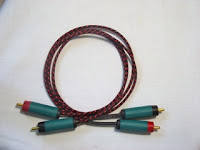Aurealis R1 – Analog Interconnects
 |
| R1 with Eichmann bullets |
The inclusion of the silver wire provides just a little extra sparkle to the upper frequency range of the music.
The all copper version of the R1 is identical in design but features 28awg copper wires instead of silver. It is a little more warm sounding and people with systems that tend to be on the bright side often prefer all copper cabling.
 |
| R1 with VaLab RCAs |
In terms of overall performance the R1s offer excellent clarity and detail. They deliver a wide frequency range and a broad soundstage.
These are very neutral sounding interconnects. Vocals and lead instruments seem to sit more naturally in the mix.
The R1s can be terminated in the following RCA connectors:
- Eichmann copper Tellurium bullets
- VaLab copper tellurium
- Eichmann silver bullets
Aurealis R2 – Analog Interconnects
 |
| R2 AgS |
R2 CuB – 30awg silver-plated copper wire terminated in Eichmann brass RCAs.
R2 CuT – 28awg Neotech copper wire terminated in Eichmann copper Tellurium RCAs.
R2 AgS – 30awg Neotech wire terminated in Eichmann silver bullets.
 |
| R2 CuT |
The sound presentation is different to the R1s. The R2s have a narrower soundstage, but more depth, and are more upfront sounding. They tend to push lead vocals and lead instruments forward from the speakers, and are a very good match for a system that may sound a touch laid back. However, some people prefer these to the R1s simply because of their more forward presentation.
 |
| R2 CuB |
In terms of the difference between the interconnects: the CuBs are lively and dynamic and a little bright. The CuTs are much more mellow and have what I describe as a warmer more coppery tone. The AgSs being an all silver interconnect are very open and smooth sounding, with excellent resolution of detail.
